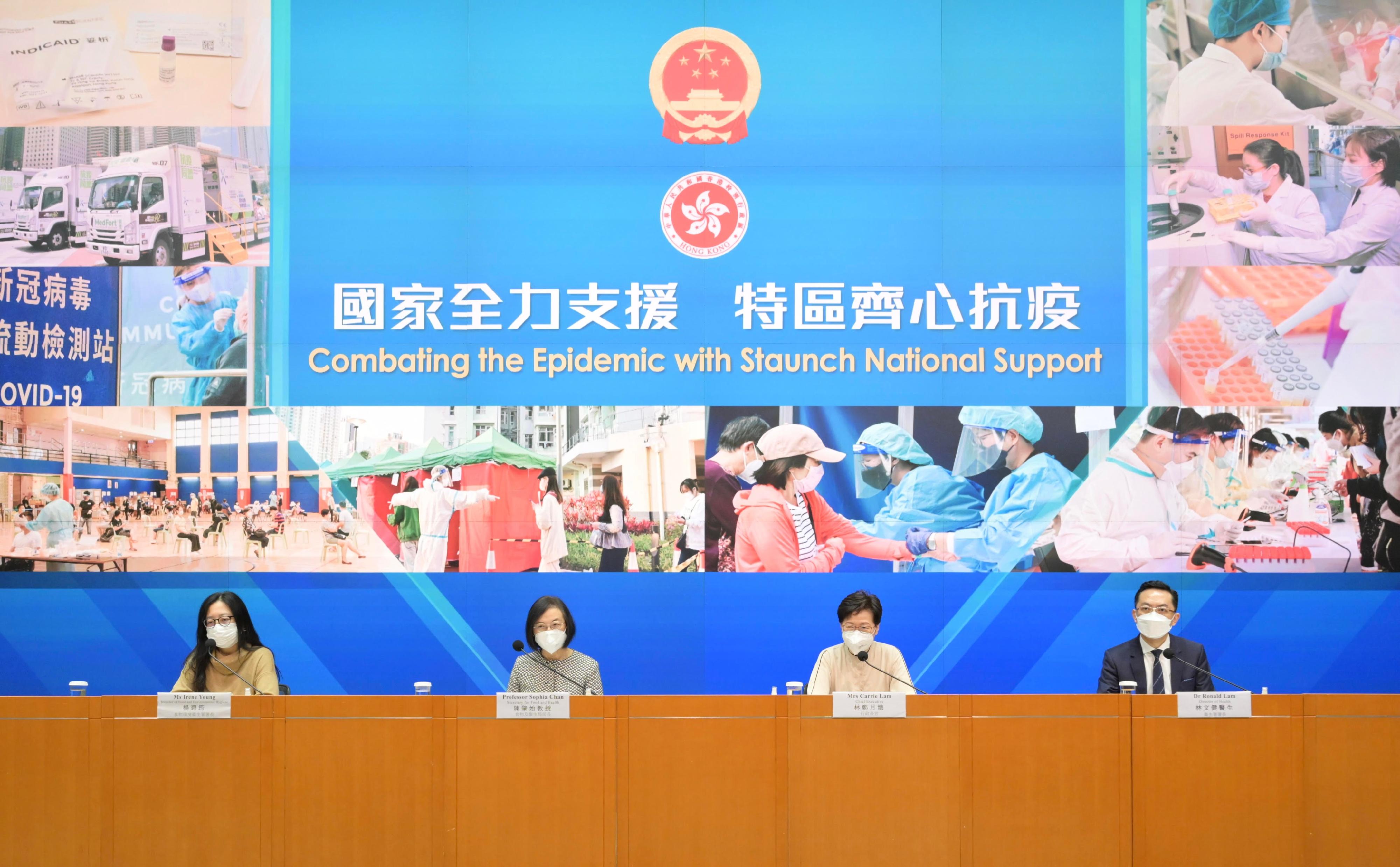The Chief Executive, Mrs Carrie Lam, held a press conference on anti-epidemic measures this morning (March 28). Also joining were the Secretary for Food and Health, Professor Sophia Chan, the Director of Food and Environmental Hygiene, Ms Irene Young, and the Director of Health, Dr Ronald Lam. Following is the transcript of remarks of the press conference:
Reporter: Good morning, Mrs Lam. A few questions. You just mentioned the lockdown and test operations could be some kind of reference to the universal testing scheme. Are you signaling the Government is preparing for universal testing again? Do you have a timetable for that? And does that mean the Government is to conduct universal testing and those who have been infected could be exempted? And you just mentioned the calculation on the mortality rate and the actual number of infections. What exactly would the Government do to, you know, adjust the statistic if you said the actual number may be higher than the reported number? Thank you.
Chief Executive: Of the two questions, the first one is about the compulsory universal testing. I said last Monday that this is still a very effective tool to use, especially if we would like to aim at eliminating any silent transmissions in the community so that we could safely resume a lot of social economic activities and, at the same time, give us the basis to negotiate or discuss with the Mainland particularly on resumption of some quarantine-free travel, of which we did achieve quite a lot of progress in the last quarter towards the end of 2021. Whatever we do now, we also bear in mind that we have this exercise in mind. We have not given up doing a comprehensive universal test but the timing of doing it is very significant because it is a mammoth exercise that we need to mobilise thousands of staff and we need to inconvenience hundreds of thousands of residents. We must find the best timing that will achieve the best result before we launch a comprehensive universal test. That's why during this period, the more we could take reference from the existing work that we are doing, the better. That's why I said we are conducting something quite similar that is an RTD, restriction-testing declaration, in which we require by law that the residents in a restricted area have to do the compulsory test and they could not leave their residence until the test result is negative; or if it is positive, then the Centre for Health Protection will arrange the necessary and suitable isolation for the infected cases.
The RTD provides us with a very good reference in several aspects. One is it has given us a good indication of the extent of infection in that restricted community. On whether it is a fresh infection case, before the test, the resident did not realise that he or she had COVID-19 virus infection. This is a fresh infection case. But now, because we have taken this extra step to ask, we are also able to discover the already infected cases or the recovered COVID-19 cases. In the current exercise, the answer to your question is already there because when we now do a restriction-testing declaration or compulsory testing, we have said categorically that if you have been infected in the last three months, then you don't need to come forward. Similarly, when we are going to conduct a comprehensive universal test, the same rule will apply because this rule is based on public health, but not based on convenience or resource considerations. The same rule will apply for a very good reason. That's the situation.
I don't have a timetable yet. It's not easy to predetermine a timetable, in the same way that I don't know how quickly the cases will come down. We are fortunate in a sense that we have seen less than 10 000 cases in the last two days. I hope this afternoon's number is also less than 10 000, but we need a bit more time to monitor the situation and then decide on when to do this.
On the mortality rates, yes, we are all very saddened by the over 7 000 deaths in the fifth wave of the epidemic. At the moment, the Centre for Health Protection has expressed the fatality rate as a percentage of the total number of positive cases recorded. It's slightly over 1 million, taking into account both the PCR (polymerase chain reaction) results and the rapid antigen test (RAT) results. But I think by now we all know that the total number of infected cases in Hong Kong should be far more than the recorded cases, because before we had a self-declaration system for RAT-tested positive residents, there could be a lot of people who had taken the rapid antigen test and tested positive. They had very mild symptoms or no symptoms and they had recovered by now. Professor Ivan Hung suggested this morning, and he actually suggested to me when we had a meeting last Saturday, that perhaps we should move on to use the grand total number of infected cases as the denominator to calculate the fatality rate. The numerator will be the same – 7 000 deaths – but whether the denominator is 1 million, 2 million, 3 million or 4 million will make a lot of difference. For the time being, we will not move to that immediate adjustment, otherwise it will cause confusion. We will monitor the situation and when we feel comfortable to decide or ascertain what exactly the denominator is, that is the total number of infected cases in Hong Kong, we may take that into account. Thank you.
(Please also refer to the Chinese portion of the transcript.)
Follow this news feed: East Asia






